七年级英语上册Unit6DoyoulikebananasSectionB1a
人教新目标英语七上Unit6Doyoulikebananas教案4
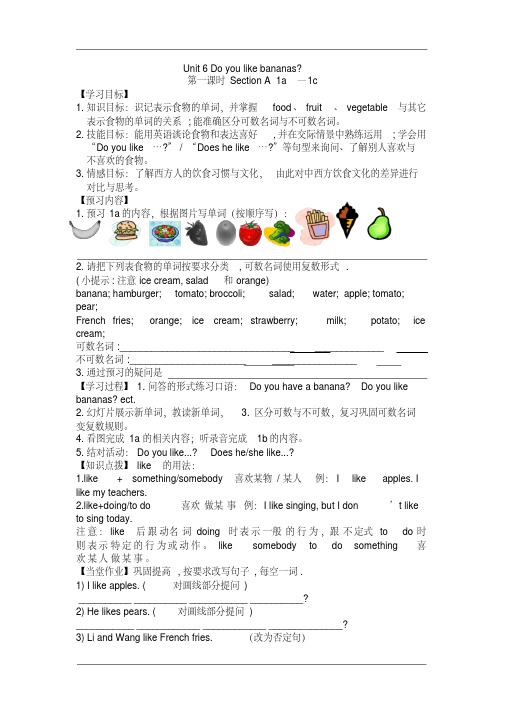
Unit 6 Do you like bananas?第一课时Section A 1a—1c【学习目标】1.知识目标:识记表示食物的单词,并掌握food、 fruit、 vegetable与其它表示食物的单词的关系;能准确区分可数名词与不可数名词。
2.技能目标:能用英语谈论食物和表达喜好,并在交际情景中熟练运用;学会用“Do you like…?” /“Does he like…?”等句型来询问、了解别人喜欢与不喜欢的食物。
3.情感目标:了解西方人的饮食习惯与文化,由此对中西方饮食文化的差异进行对比与思考。
【预习内容】1.预习1a的内容,根据图片写单词(按顺序写):2.请把下列表食物的单词按要求分类,可数名词使用复数形式.(小提示:注意ice cream, salad和orange)banana; hamburger; tomato; broccoli; salad; water; apple; tomato; pear;French fries; orange; ice cream; strawberry; milk; potato; ice cream;可数名词:_________________________________ _____________不可数名词:______________________ ________________3.通过预习的疑问是【学习过程】1.问答的形式练习口语:Do you have a banana? Do you like bananas? ect.2.幻灯片展示新单词,教读新单词,3.区分可数与不可数,复习巩固可数名词变复数规则。
4.看图完成1a的相关内容;听录音完成1b的内容。
5.结对活动:Do you like...? Does he/she like...?【知识点拨】like 的用法:1.like + something/somebody 喜欢某物/某人例:I like apples. I like my teachers.2.like+doing/to do喜欢做某事例:I like singing, but I don’t like to sing today.注意:like后跟动名词doing时表示一般的行为,跟不定式to do时则表示特定的行为或动作。
七年级英语上册Unit6DoyoulikebananasSectionB1a,1b,1c,1d,1e

四川省射洪县外国语学校七年级英语上册《Unit 6 Do you li ke bananas SectionB 1a ,1b,1c,1d,1e》导学案(无答案)人教新目标版执教教师:学生姓名单元主题Unit 6 Do you like bananas? 课题Section B 1a,1b,1c,1d,1e学习准备课本,导学案,练习本学习过程疑问、收获A1 Activation (激活)1.跟老师一起快乐进入课堂。
2.迅速回顾一些蔬菜水果食物的词汇以及句型。
A2 Aims (树标)我们的课题:利用蔬菜水果食物名词练习 Do you like... ?的句型。
我们的目标:我要听懂和写出以上名词,我还要学会这个句型。
A3 Activity(实战)一. Preparation.听前热身.完成Sectio n B 1a.二.听录音,将所听到的单词填写在横线上.录音播放两遍.A4 Application(迁移运用)Sally: Do you like carrots?Tom: Yes, I do. I like all vegetables.Sally: How about salad? Do you like salad?Tom: Yes, I do. It's great! Do you like vegetables?Sally: No, I don't like vegetables. Well, only salad. But I like fruit. I like bananasand oranges ...Tom: How about apples? I don't li ke apples!Sally: Yes, I like apples. And you know w hat I really like?Tom: What?Sally: Ice-cream!一.再听一遍听力材料,完成一下问题。
七年级人教版英语上册Unit6Doyoulikebananas?全单元教案

Unit 6Do you like bananas?Period 1(Section A 1a-1c)Teaching aims1. Learn words and be able to say, read and write them:orange(s), banana(s), strawberry, strawberries, pear(s), apple(s),tomato(es), carrot(s), vegetable(s), hamburger(s), egg(s), ice-cream(s),salad(s), bread, chicken2. Be able to talk about likes and dislikes by using:I/We/They like oranges. He/She likes oranges.I /We/They don’t likebananas. He/She doesn’t like hamburgers.Do you like salad? Yes, I do./No, I don’t.Does he/she like tomatoes? Yes, he/she does. / No, he/she doesn’t.3.Understand the difference between countable nouns and uncountable nouns.Teaching key and difficult points:1.Learn these words and be able to say, read and write them:2.Be able to talk about likes and dislikes by using:I/We/They like oranges. He/She likes oranges.I /We/They don’t likebananas. He/She doesn’t like hamburgers.Do you like salad? Yes, I do./No, I don’t.Does he/she like tomatoes? Yes, he/she does. / No, he/she doesn’t. Moral objects(1)To call students ’ attention to otherserests and’ei n ablet themto care more about classmates.(2)To improve Sts ’communicating skills and enable them to keeptheir health.教学设计备注Step 1. Warm-up and revision(1)Daily greeting to the students(2)Revision: What ’s this/that in English ? What coloris it?T:What ’s this in English? (show a picture of andorange)T:What color is it?Step 2. Presentation –New words.(1)Go on asking: What ’s this/that in English ? Whatcolor is it?T:What ’s this in English? (show a picture of anapple and if the student don’t know it, show thephonetic symbol of the word.)T: Spell it, please.S: A-P-P-L-E.T: What color is it?S: It ’s red.(Present the other three words as above: pear,strawberry, banana )T:We can call all of these things fruit . (Teach the newword “fruit ”.)Show pictures and ask the Ss “What arethese/those? ”and ask the SS to spell the pluralforms of these words: oranges, apples, pears,strawberries, bananas.(2)Repeat step (1) to present: carrot, carrots,tomato, tomatoes and vegetable, vegetables.(3)Present some more words by showing pictures. Get theSs to make an effort to pro nounce and spell the new words.Bread, hamburger ,hamburgers, milk, ice-cream,ice-creams, salad, chicken ,an egg, eggsWe can call all of these things food:食物3.Memory Challenge: Who has the best eyes?(1)Show the pictures, and say the plural forms of the nouns andsome uncountable noun.(2)Summarize. 可数名词有复数形式 , 不可数名词一般没有复数形式Step 3Presentation Target language 11. Show the pictures and say:I like tomatoes, but I don’ t like bread.2.Let students say:I like, but I don’t like ....3. Show the pictures and say:She likes bread, but she doesn’t like milk.He likes chicken, but he doesn’t like eggs.4.Let students say: He/She likes , but he/she doesn’tlike ....According Ss’answers and say:5. Sing a chant:Bananas, bananas, I like bananas! Salad, salad, I like salad!Strawberries, strawberries,I don ’t like strawberries!Pears, pears, he likes pears!Milk , milk, he likes milk!Tomatoes, tomatoes,He doesn ’t like tomatoes! Step 4 Work 1a .1. Read the words.2.T: Look at the pictures and fill in the chart .Fruit Food Vegetable3.Match the words with the things in the picture.4.Check the answers .Step 5 Present the new language 1 .1. T: Oh, we have lots of delicious fruits . I like apples best.Do you like apples ?S1 :Yes , I do. I like apples.S2: No, I don't . I like salad.T: Do you like salad ? S3: Yes , I do. I like salad./ No, I don't . I don’tlike salad.Step 6 Pairwork .1. T: Work in pairs .Ask and answer with your partners .(Before class the students have draw some pictures of the food )2. Get the Ss to ask and answer in pairs, using the sentences:’t.A: Do you like ?B: Yes, I do./ No, I don 3. When you ask andanswer, please fill in the chart. Name Like DislikeStep 7 Present the new language 2 .1.Show pictures and ask and answer questionsDoes she/he like ?Yes, she/he does. She/He likes/ No, she/he doesn ’t. She/He doesn ’tlike .Step 8 Pairwork .1. T: Work in pairs .Ask and answer with your partners .2.Get the Ss to ask and answer in pairs, using the sentences:Does she/he like ?Yes, she/he does. She/He likes/ No, she/he doesn ’t. She/He doesn ’tlike .3.According Ss’answers and ask “Do they like ? Yes, they do./ No, they don’t.”Step 9 Work on 1b.1.T: 1b. List en and number the conversations.2.Listen.3.Check the answers.4.Read after the tape.Step 10 work on 1c.1.First, practice the conversations in 1b.Then, make a survey and fill in the chart below.2. Report: I like milk and tomatoes, but I don’t like ice-cream. Mary likes oranges, but she doesn’liket milk orice-cream. Tom likes tomatoes and strawberries, but hedoesn ’ t like bread.Step 11 . HomeworkWrite down the report.Blackboard design:New Words Unit 6 Do you like bananas?Do you like?Yes , I do. I likeNo ,I don ’t. I don ’tlikeDoes she/he like ?Yes, she/he does. She/He likes/No, she/he doesn ’t. She/He doesn ’tlike.Period 2(Section A 2a-2d)Teaching aims:1. Words & expressionsBirthday, dinner, week, think about, food, sure, how/whatabout ? Burger, vegetable, fruit, apple, then2. Target languageI like strawberries, they’re delicious. Let’s have them.--Yes, I like them ,too./ No, I don’tlike them.I like salad, it ’s delicious. Do you like it?-- Yes, I do./No, I don’t but I likeice cream.Let ’ s have Let ’s think about the food.Ability goalsEnable students to talk about likes and dislikes.Learning ability goalsHelp students learn how to talk about likes and dislikes.2. Listening and speaking skills.Moral object:Learn to keep healthy.Teaching important / difficult pointsHow to talk about likes and dislikes with the target language.教学设计备注Step1 Warm up and revision.1.Everyday greeting.2.Review.Show the pictures and say the singularforms and the plural forms of the countable nouns.3.Show some pictures of the uncountable nouns.4.Summarize.(1).当可数名词复数再次出现时,用“They( 主语)或 them(宾语)”替代。
人教版七年级英语上册Unit6Doyoulikebananas教案

人教版七年级英语上册Unit6 Do you like bananas教课设计课题Unit 6 Section A 1a /1b /1c /2a /2b.课型New一、知识与技术:1)单词:do,don ’ t,does,doesn’ t,strawberries,like,have,bamburgers,orange,tomatoes,icecream,broccoli,salad,French fries, bananas.2)句型: Do you like bananas?教课目的Yes, I do. \ No, I don’ t.经过学习本课,学生能够用英语相互议论喜爱与不喜爱的食品。
二、过程与方法:1)睁开多种任务型的听力活动,获取理解、辨别和办理与讨论爱好、憎恶有关的信息。
2)经过小组议论、睁开检查等研究,明确在用中学、沟通中学习的想法。
三、感情态度价值观:议论美食,享受生活美味,倡导健康合理饮食。
教课要点掌握对于食品的词汇。
教课难点学会使用社交用语 Do you like bananas? Yes,I do.\ No, Idon ’ t.课前准备录音机、多媒体课件教课过程:设计企图Step1. Warming upStep 2 Presentation经过让学生猜冰箱里有哪些食品的形式,导出新的单词。
同时让全体学生拼读每个单词、让个别学生将单词写到黑板上。
Step3.Task 1部署一项任务:老师手持一个盒子, 让同学猜猜老师最喜爱的食品.规则为学生只好问老师问题而老师只用“Yes”或“No”回答。
达成 Section A, 1a, 1b.Step 4. Task 2部署拓展性任务:要求同桌学生合作编一个小型对话,主题为咨询他人喜爱或不喜爱的食品。
要求使用刚学过的食品类单词以及句型,同时也能够适合地加入课外单词(老师请一程度较好的学生先进行示范)。
Step 5.达成课文32 页 Section A 听力练习activity 2a, 2b.Setp 6.当堂听写听写单词与句型,进一步稳固本课学习内容,并将本课应掌握的单词和句型落实到“写”上,使学生不只会说同时会写。
人教版七年级上册英语Unit6Doyoulikebananas
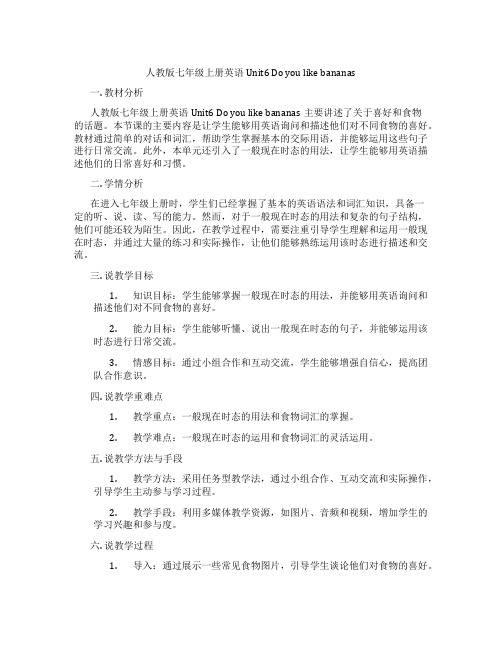
人教版七年级上册英语Unit6 Do you like bananas一. 教材分析人教版七年级上册英语Unit6 Do you like bananas主要讲述了关于喜好和食物的话题。
本节课的主要内容是让学生能够用英语询问和描述他们对不同食物的喜好。
教材通过简单的对话和词汇,帮助学生掌握基本的交际用语,并能够运用这些句子进行日常交流。
此外,本单元还引入了一般现在时态的用法,让学生能够用英语描述他们的日常喜好和习惯。
二. 学情分析在进入七年级上册时,学生们已经掌握了基本的英语语法和词汇知识,具备一定的听、说、读、写的能力。
然而,对于一般现在时态的用法和复杂的句子结构,他们可能还较为陌生。
因此,在教学过程中,需要注重引导学生理解和运用一般现在时态,并通过大量的练习和实际操作,让他们能够熟练运用该时态进行描述和交流。
三. 说教学目标1.知识目标:学生能够掌握一般现在时态的用法,并能够用英语询问和描述他们对不同食物的喜好。
2.能力目标:学生能够听懂、说出一般现在时态的句子,并能够运用该时态进行日常交流。
3.情感目标:通过小组合作和互动交流,学生能够增强自信心,提高团队合作意识。
四. 说教学重难点1.教学重点:一般现在时态的用法和食物词汇的掌握。
2.教学难点:一般现在时态的运用和食物词汇的灵活运用。
五. 说教学方法与手段1.教学方法:采用任务型教学法,通过小组合作、互动交流和实际操作,引导学生主动参与学习过程。
2.教学手段:利用多媒体教学资源,如图片、音频和视频,增加学生的学习兴趣和参与度。
六. 说教学过程1.导入:通过展示一些常见食物图片,引导学生谈论他们对食物的喜好。
2.新课呈现:引入一般现在时态的概念,并通过示例句子让学生理解一般现在时态的用法。
3.对话练习:让学生听录音或观看视频,模仿对话中的句子,并进行角色扮演。
4.小组活动:学生分组进行讨论,用英语询问和描述他们对食物的喜好。
5.巩固练习:通过完成练习题和互动游戏,让学生进一步巩固一般现在时态的用法。
人教版英语七年级上册 Unit 6 Do you like bananas

This is a fruit and vegetable house (果疏屋). What’s in the house? (果蔬屋里有什么?)
some vegetables
some fruits
banana bananas
pear pears
strawberry strawberries
2 A: Do you like salad? B: No, I don’t.
1 A: Do you like bananas? B: Yes, I do.
3 A: Do you like oranges? B: Yes, I do.
Post-listening
1c Practice the conversations with your partner. Then make your own conversations.
2. tomatoes __i _ 3. oranges _f__ 4. ice-cream _h__ 5. salad __b_ 6. bananas _g__
7. strawberries __c_ 8. pears __j_
9. milk __e_ 10. bread _a__
Read the dialogue in the picture.
Read the conversation after the tape.
1. Girl: I like hamburgers. Do you like hamburgers? Boy: Yes, I do.
2. Girl: Do you like tomatoes? Boy: No, I don't like tomatoes.
—Do you like bananas? —Yes, I do. —Do you like salad? —No, I don’t. —Do you like oranges? —Yes, I do.
人教版英语七年级上册 Unit 6 Section B教案
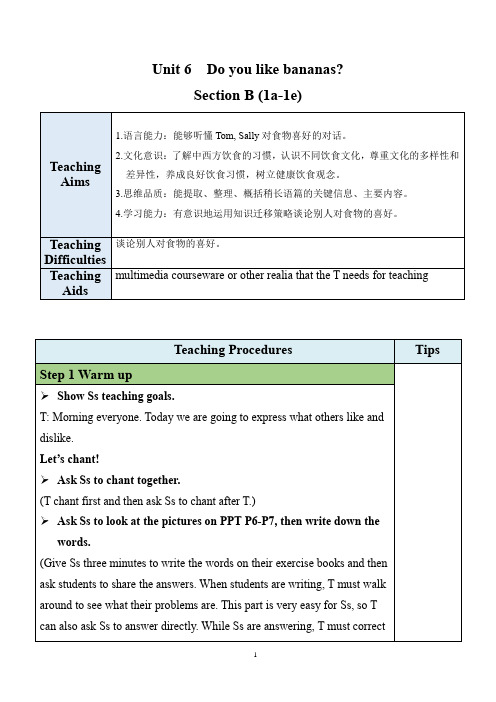
Unit 6 Do you like bananas?Section B (1a-1e)Unit 6 Do you like bananas?Section B (2a-2c)➢Ask Ss to write more healthy food and unhealthy food.Answers will vary.While-readingFirst Reading➢Reading Tip 1: PredictingT asks Ss to look at the title and pictures in 2b, try to predict: What's the article about?(T tells Ss what predict is: to have a guess. Any answer is OK here. Ss can tell the reason why they guess so.)Second Reading➢Reading Tip 2: scanningAsk Ss to scan the passage and complete the thinking map.➢Reading Tip 3: ScanningAsk Ss to judge which sentence is right and which sentence is wrong according to the passage.Answers: 1. F 2. F 3. T 4. T 5. TThird Reading➢Reading Tip 4: RetellingT asks Ss to retell the passage.(T can use the table above and give some clues to help Ss retell. T can say the first words of the sentences or use transitional words or questions to remind them of the next sentence if students forget. There will be somegrammatical mistakes when they are retelling, so teachers must use some transitional words to connect the sentences together, or to correct their pronunciations.)2b➢Ask Ss to read the magazine article and circle the food words.➢T ask Ss to write down the food that Cindy likes for meals and David likes for meals.T: Just now you have circled all the words about food. What does Cindy like for breakfast, lunch and dinner? What does David like for breakfast, lunch and dinner? Now write B for breakfast, L for lunch and D for dinner after the words.➢Let each S take out a piece of paper. Show Ss PPT P18 and ask them to write down the Chinese translation for each phrase.2c➢Ask Ss to write down five sentences about Cindy’s eating habits. While Ss are completing 2c, walk around the room and look at the sentence of different Ss. Choose sentences in which there are common errors, and write these sentences on the board. Then have Ss work in pairs to find the errors and suggest corrections. Elicit from Ss how to correct the sentences, and make the corrections on the board.Answers will vary.Post-reading➢Optional choice: Divide Ss into groups of four. Ask them to discuss what they like to eat for each meal. T can encourage Ss to say more about their preferences, e.g. I like ... but I don’t like ..., I always / never have ... for ... (T can write these sentences on the board if necessary).Unit 6 Do you like bananas? Section B (3a-Self Check)Exercise 1➢Ask Ss to write the plural forms of the words in the box on the left, then put them into the correct columns.Answers 1:Exercise 2➢First, ask Ss to choose a topic (i.e. the food / sports / colors they like or dislike), then let them write five sentences for that topic. Answers will vary.Exercise 3➢Tell Ss that they need to think about the food / sports / colors their parents like and write five sentences.Answers will vary.(T can encourage Ss to correct each other’s sentences first, then pick some Ss to read their answers to the whole class. )。
人教版七年级英语上册教案(RJ) Unit 6 Do you like bananas

Unit 6Do you like bananas?第一课时Section A(1a-1c)1.重点单词:banana,hamburger,tomato,icecream,salad,strawberry,pear,milk,bread2.重点句式:—Do you like bananas?—Yes,I do.—Do you like salad?—No,I don't.1.用like来谈论喜好2.可数名词的单复数1.用like来谈论喜好2.可数名词的单复数一、预习课本P31新单词并背诵,完成下面的汉译英。
1.香蕉____________ 2.汉堡____________3.西红柿____________ 4.冰激凌__________5.沙拉____________ 6.草莓____________7.梨____________ 8.牛奶____________9.面包____________二、认真预习1a,1b,1c,找出下列句型。
1.—你喜欢香蕉吗?—是的,我喜欢。
________________________________________________________________________ 2.—你喜欢沙拉吗?—不,我不喜欢。
________________________________________________________________________Step 1情景导入Teacher:There are many different kinds of fruits and vegetables in the world,and different people like different food.Everyone has its own taste.What kind of food do you like?What kind of food do you dislike?Today let's talk about the food we like and we dislike in Unit 6.环节说明:由学生感兴趣的话题导入新课,简洁明了,激起学生的学习兴趣。
初一英语上册Unit_6_Do_you_like_bananas_SectionB
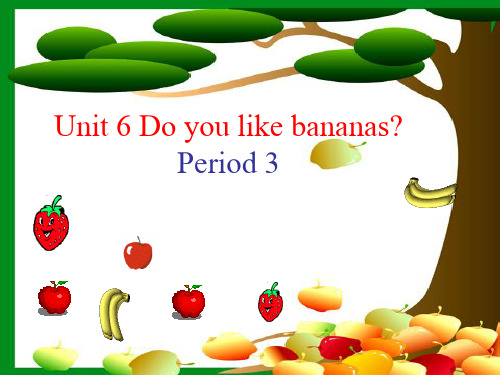
19
rice
22
3
6
7
8
3
4
7 10
41615102
5
8
9
breakfast lunch
dinner/supper
1a
What does she have /like for …..?
1B Groupwork: How many other words can you add to the lists?(四人一组写出其它单词, 可用词典,看哪组写得最多)
A:What do you have/like for breakfast/…?
B:I have/like….for breakfast.She/he has/likes…for breakfast
breakfast lunch dinner/supper
I
milk,bread
vegetables rice,meat
Pair work
A: What do you have/like for breakfast/Lunch/dinner(supper)? B: I have/like…for breakfast/lunch/dinner? C:What does she/he have/like for breakfast/ lunch/dinner(supper)? D:She/He has/likes…for breakfast/lunch/dinner.
She has a banana and a hamburger for breakfast. Does she have a banana and a hamburger for breakfast?
Yes ,she does.
人教版七年级英语上册教师用书课件:Unit6 Do you like bananasSection B-1

Ⅲ.单项选择
1.My friend Li Lei likes salad, but I don't like A at all.
A.it
B.them
C.its
D.they
解析:salad是不可数名词,代词应用it。
2.— A does your father have ________ lunch? —Chicken and tomatoes. A.What; for B.What; / C.How; for D.How; / 解析:由答语可知问句句意应是“午饭你爸爸吃什 么?”,应表达为“What does your father have for lunch?”。 故选A。
3.For D lunch, she has some hamburgers. A.a B.an C.the D./ 解析:一日三餐前不应加冠词。 4.Tommy likes milk, C for breakfast. A.egg and tomato B.egg and tomatoes C.eggs and tomatoes D.eggs and tomatos 解析:egg和tomato都是可数名词,此处都应用复数, tomato的复数应在其后加-es,故选C。
Ⅰ.根据句意及首字母提示写单词
1.Lin Shuhao is a basketball star .
2.I like vegetables for lunch
.
3.I have a good eating habit
.
4.He has a question to ask.
5.I was a fat
2.What do you like for breakfast? 早饭你喜欢(吃)什么? (1)What do/does sb.like for+某餐?意为“某人某餐喜欢 (吃)什么?”。例: What does your mother like for dinner? 你妈妈晚餐喜欢吃什么?
人教版新目标版七年级英语上册 Unit 6 Do you like bananas 教案

Unit 6 Do you like bananasUnit 6 Do you like bananas? 教学设计⑥1.复习词汇:like 2.词汇:banana ,hamburger ,tomato ,broccoli ,French fries , orange ,ice cream ,salad ,strawberry ,breakfast ,lunch , dinner ,egg ,apple ,chicken ,fruit ,vegetable3.句型:Do you/they like salad? Yes ,I/they do ./No ,I /they don ’t .Does he/she like salad? Yes ,he/she does ./No ,he/she doesn ’t.I/They like oranges . I/They don ’t like oranges .He/She likes ice cream . He/She doesn ’t like bananas .语法重点:动词like 一般现在时的肯定句、否定句和一般疑问句的用法以及肯定与否定的回答。
Step Ⅱ Exercise 随堂练习设计(1)翻译填空1.你喜欢吃香蕉吗? _______ you __________ bananas?2.艾米丽的哥哥不喜欢吃草莓。
Emily’s brother ________ _______strawberries .3.凯特早餐吃鱼吗? ______ Kate like fish ________ breakfast?4.你晚饭常常吃什么? What _______ you usually have ______ _________?5.我叔叔常常吃冰淇淋作甜食。
My uncle usually ______ ice cream ______ dessert .(2) 用所给词的适当形式填空1. Bob (like) French fries.2. I want some ______(tomato) for dinner3. Would you like some ______(salad)?4. How ______(much) eggs do you have?5. You can see ________ (lot) of pictures in his room.(3) 任务型阅读:根据表格内容完成下面的短文NameJoy Smith AgeFifteenlike SportFoodColoryellowDislike Sport FoodColor red Joy is a boy. He is fifteen years old. His last name is __________. Hoy is his _________ name. He likes to play ___________. He doesn’t like to play __________.。
人教版七年级英语上册教学课件:Unit 6 Do you like bananas(共90张PPT)
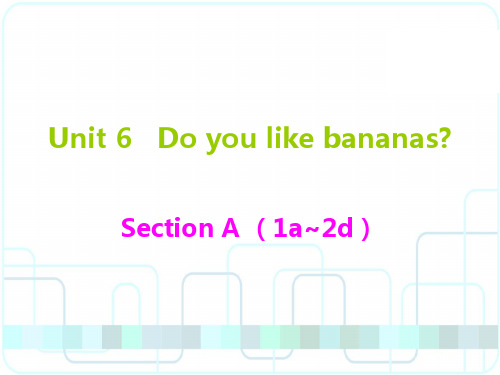
课堂练习
三、根据汉语意思完成句子,每空一词 1. 你喜欢草莓吗? Do you ___li_k_e__ ___s_tr_a_w_b__e_rr_ie_s___? 2. ——你喜欢苹果吗? ——不,我喜欢梨。 —Do you __li_k_e__ __a_p_p_le_s_? —No, I __d_o__n_'t__. I __li_k_e__ __p_e_a_r_s__.
Unit 6 Do you like bananas?
Section A (1a~2d)
课前导学
核心单词 1. ___b_a_n_a_n_a____ n. 香蕉 2. ____h_a_m_b_u_r_g_e_r____ n. 汉堡包 3. ____t_o_m_a_t_o____ n. 西红柿 4. ___i_c_e_-c_r_e_a_m____ n. 冰激凌 5. ____s_a_l_a_d___ n. 沙拉 6. __s_t_r_a_w_b_e_r_ry____ n. 草莓 7. ____p_e_a_r____ n. 梨 8. ____m_i_lk______ n. 牛奶
要点梳理
2. sure的用法 【教材例句】—Let's think about the food. 让我们来 想想(吃什么)食物吧。 —Sure. 当然。 (教材第32页) 【要点思维导图】
要点梳理
【举例】 —Can you help me? 你能帮我吗? —Sure. 当然可以。 I am sure he can come to my birthday party. 我确信 他会来参加我的生日聚会。
要点梳理
2 句型“How about …?”的用法 【教材例句】How about burgers, vegetable salad, and some fruit? 汉堡包、蔬菜沙拉和一些水果怎么样? (教材第32页) 【用法】“How about …?”意为“(提出建议)…… 怎么样?”,用于提出建议或请求,相当于“What about …?”,其中about为介词,后接名词、代词或 动词-ing形式。
七年级上册 Unit 6 do you like bananas课件Section A 1a-1c (非三人称)
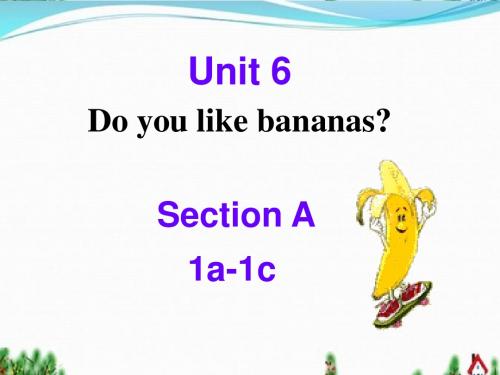
Do you like hamburgers? they Tom and Sally
Yes, I do. No , I don’t.
Yes, they do. No , they don’t.
Yes, they do. No , they don’t.
Do you
they Tom and Sally
1a Match the words with the things in the
picture. 1. hamburgers __ d i 2. tomatoes __ f 3. oranges __ 4. ice-cream h __ b 5. salad __ g 6. bananas __ 7. strawberries __ c j 8. pears __ 9. milk __ e a 10. bread__
Ice cream
I like…but I don’t like…
Exercise
一、选词填空。
√ 1. Do you like ___ (strawberry/strawberries)? √ 2. Here are some nice ___ (tomatos/tomatoes). √ / has) apples and bananas. 3. Let’s ___ (have
1c Pairwork
Practice the conversations above. Then make your own conversations. A: Do you like pears? B: No, I don’t. A: Do you like tomatoes? B: Yes, I do.
III. Translate and write them down. 1. - 你喜欢沙拉吗? - 我不喜欢。 - Do you like salad? - No, I don’t. 2. 我喜欢花椰菜,但我不喜欢炸薯条。 I like broccoli, but I don’t like French fries.
七年级英语上册 Unit 6 Do you like bananas Section B(1a-1e)教案
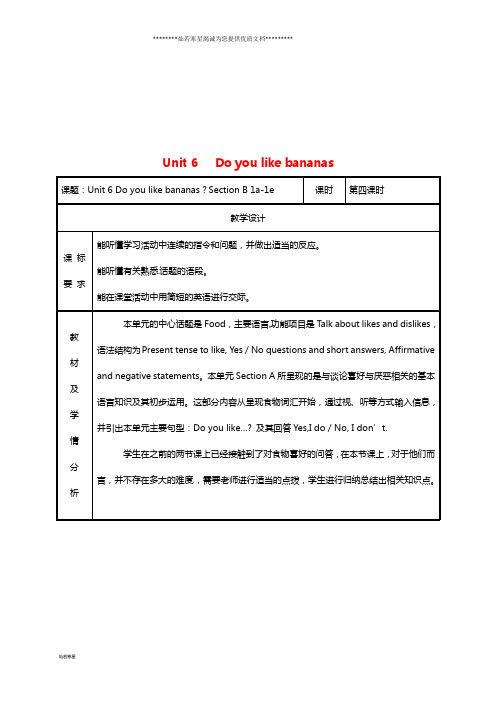
Unit 6 Do you like bananas课题:Unit 6 Do you like bananas?Section B 1a-1e 课时第四课时教学设计课标要求能听懂学习活动中连续的指令和问题,并做出适当的反应。
能听懂有关熟悉话题的语段。
能在课堂活动中用简短的英语进行交际。
教材及学情分析本单元的中心话题是Food,主要语言功能项目是Talk about likes and dislikes,语法结构为Present tense to like, Yes / No questions and short answers, Affirmative and negative statements。
本单元Section A所呈现的是与谈论喜好与厌恶相关的基本语言知识及其初步运用。
这部分内容从呈现食物词汇开始,通过视、听等方式输入信息,并引出本单元主要句型:Do you like…? 及其回答Yes,I do / No, I don’t.学生在之前的两节课上已经接触到了对食物喜好的问答,在本节课上,对于他们而言,并不存在多大的难度,需要老师进行适当的点拨,学生进行归纳总结出相关知识点。
引入新课Step 1.Warming- upand revision1 . Daily greeting to the students.2. Review the words on food. 练习旧知,由此进入新知识的学习Section B, 1a. 1. T: First practice reading the words by2. T: Now, please look at the pictures.4. Check the answers with the students.学生通过对单词和图片again and then listen to a conversation,2. Check the ans wers by asking 听力练习。
人教版七年级上册英语例题与讲解:Unit6DoyoulikebananasSectionB
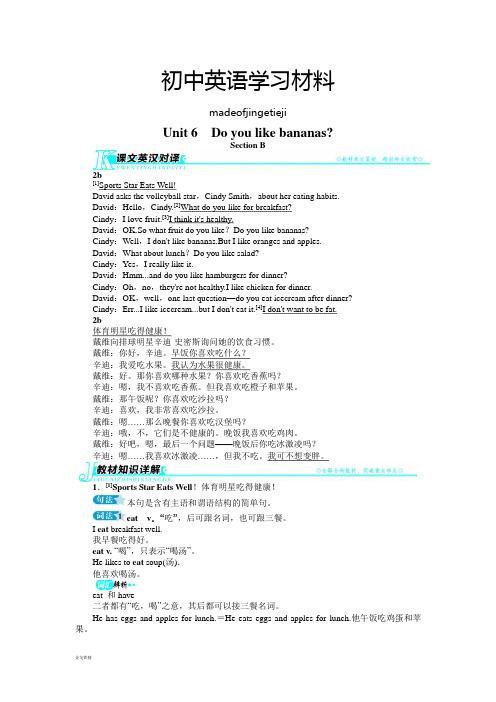
初中英语学习材料madeofjingetiejiUnit 6Do you like bananas?Section B2b[1]Sports Star Eats Well!David asks the volleyball star,Cindy Smith,about her eating habits.David:Hello,Cindy.[2]What do you like for breakfast?Cindy:I love fruit.[3]I think it's healthy.David:OK.So what fruit do you like?Do you like bananas?Cindy:Well,I don't like bananas.But I like oranges and apples.David:What about lunch?Do you like salad?Cindy:Yes,I really like it.David:Hmm...and do you like hamburgers for dinner?Cindy:Oh,no,they're not healthy.I like chicken for dinner.David:OK,well,one last question—do you eat icecream after dinner?Cindy:Err...I like icecream...but I don't eat it.[4]I don't want to be fat.2b体育明星吃得健康!戴维向排球明星辛迪·史密斯询问她的饮食习惯。
戴维:你好,辛迪。
早饭你喜欢吃什么?辛迪:我爱吃水果。
我认为水果很健康。
戴维:好。
那你喜欢哪种水果?你喜欢吃香蕉吗?辛迪:嗯,我不喜欢吃香蕉。
但我喜欢吃橙子和苹果。
武陵区第八中学七年级英语上册 Unit 6 Do you like bananas Section
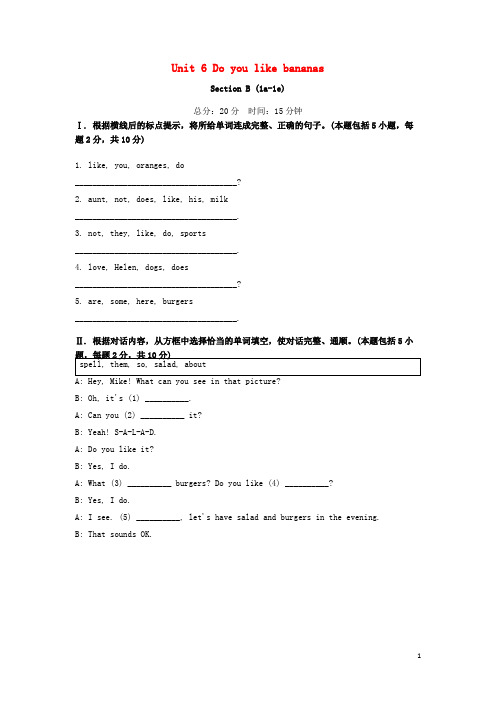
Unit 6 Do you like bananasSection B (1a-1e)总分:20分时间:15分钟Ⅰ. 根据横线后的标点提示,将所给单词连成完整、正确的句子。
(本题包括5小题,每题2分,共10分)1. like, you, oranges, do_____________________________________?2. aunt, not, does, like, his, milk_____________________________________.3. not, they, like, do, sports_____________________________________.4. love, Helen, dogs, does_____________________________________?5. are, some, here, burgers_____________________________________.Ⅱ. 根据对话内容,从方框中选择恰当的单词填空,使对话完整、通顺。
(本题包括5小B: Oh, it's (1) __________.A: Can you (2) __________ it?B: Yeah! S-A-L-A-D.A: Do you like it?B: Yes, I do.A: What (3) __________ burgers? Do you like (4) __________?B: Yes, I do.A: I see. (5) __________, let's have salad and burgers in the evening.B: That sounds OK.参考答案:Ⅰ. 1. Do you like oranges2. His aunt does not like milk3. They do not like sports4. Does Helen love dogs5. Here are some burgersⅡ. 1. salad 2. spell 3. about 4. them 5. SoSection A第2课时(3a~3c)类别学习重点重点单词 north重点句式—Where’s the bank?—The bank is next to the hospital and across from the park。
- 1、下载文档前请自行甄别文档内容的完整性,平台不提供额外的编辑、内容补充、找答案等附加服务。
- 2、"仅部分预览"的文档,不可在线预览部分如存在完整性等问题,可反馈申请退款(可完整预览的文档不适用该条件!)。
- 3、如文档侵犯您的权益,请联系客服反馈,我们会尽快为您处理(人工客服工作时间:9:00-18:30)。
有些同学在听课的过程中常碰到这样的问题,比如老师讲到一道很难的题目时,同学们听课的思路就“卡壳“了,无法再跟上老师的思路。这时候该怎么办呢?
如果“卡壳”的内容是老师讲的某一句话或某一个具体问题,同学们应马上举手提问,争取让老师解释得在透彻些、明白些。
如果“卡壳”的内容是公式、定理、定律,而接下去就要用它去解决问题,这种情况下大家应当先承认老师给出的结论(公式或定律)并非继续听下去,先把问题 记下来,到课后再慢慢弄懂它。
编后语
有的同学听课时容易走神,常常听着听着心思就不知道溜到哪里去了;有的学生,虽然留心听讲,却常常“跟不上步伐”,思维落后在老师的讲解后。这两种情况都 不能达到理想的听课效果。听课最重要的是紧跟老师的思路,否则,教师讲得再好,新知识也无法接受。如何跟上老师饭思路呢?以下的听课方法值得同学们学习:
老师没提了一个问题,同学们就应当立即主动地去思考,积极地寻找答案,然后和老师的解答进行比较。通过超前思考,可以把注意力集中在对这些“难点”的理 解上,保证“好钢用在刀刃上”,从而避免了没有重点的泛泛而听。通过将自己的思考跟老师的讲解做比较,还可以发现自己对新知识理解的不妥之处,及时消除知 识的“隐患”。
Section B (1a- 2.午餐 lunch 3.鸡肉 chicken 4.胡萝卜 carrot 5.西红柿 tomato 6.米饭 rice
ⅠⅡ
Ⅱ.完成句子
1.——你喜欢梨吗?
——是的,我喜欢。
— Do
you
like pears
一、“超前思考,比较听课”
什么叫“超前思考,比较听课”?简单地说,就是同学们在上课的时候不仅要跟着老师的思路走,还要力争走在老师思路的前面,用自己的思路和老师的思路进行 对比,从而发现不同之处,优化思维。
比如在讲《林冲棒打洪教头》一文,老师会提出一些问题,如林冲当时为什么要戴着枷锁?林冲、洪教头是什么关系?林冲为什么要棒打洪教头?••••••
?
—Yes,I do
.
2.——汤姆喜欢胡萝卜吗?
——是的,他喜欢。
—
Does
Tom
like carrots
?
—Yes,he does .
breakfast,lunch,dinner 早餐,午餐,晚(正)餐 剖析三者均为名词,常用于短语have breakfast/lunch/dinner 吃早/ 中/晚(正)餐,注意此短语中的三餐名词前面不用冠词,但可以说have a big/good breakfast/lunch/dinner “好好吃了一顿早/中/晚(正)餐”。 辨析dinner,supper dinner一般指的是“正餐;主餐”,可以是午餐,也可以是晚 餐;supper仅指晚餐,通常指非正式场合的晚餐。
精选最新中小学教学课件
6
尖子生好方法:听课时应该始终跟着老师的节奏,要善于抓住老师讲解中的关键词,构建自己的知识结构。利用老师讲课的间隙,猜想老师还会讲什么,会怎样讲, 怎样讲会更好,如果让我来讲,我会怎样讲。这种方法适合于听课容易分心的同学。
2019/7/14
精选最新中小学教学课件
5
thank
you!
2019/7/14
